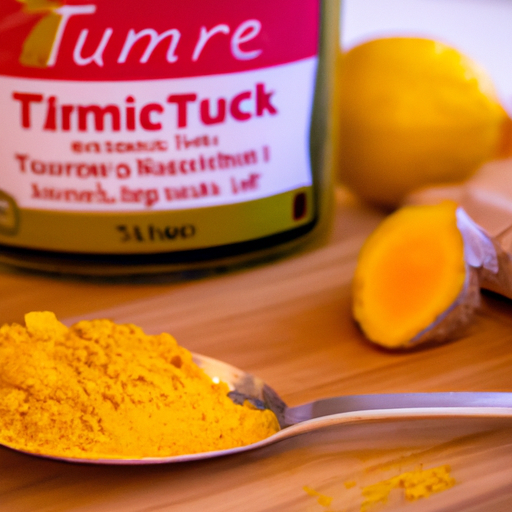As a person who is constantly seeking natural methods to enhance my health, I frequently come across the advantages of turmeric. This vibrant yellow spice has been utilized in traditional medicine for many years, and contemporary studies have validated its anti-inflammatory and antioxidant characteristics.
But with so many forms of turmeric available – from capsules to teas to powders – it can be hard to know the best way to take it for maximum benefit.
In this article, I’ll share what I’ve learned about the different forms of turmeric, their benefits and considerations, and dosage recommendations. I’ll also discuss the best time to take turmeric, how to prepare turmeric tea, and how to incorporate turmeric into cooking.
Finally, I’ll touch on potential side effects and precautions to keep in mind. Whether you’re looking to ease inflammation, support digestion, or simply add some flavor to your meals, this guide will help you make the most of this powerful spice.
Key Takeaways
- Choosing the form of turmeric consumption depends on personal preferences, lifestyle, allergies, medical conditions, quality, and brand.
- Consult a healthcare professional before taking supplements or adding turmeric to the routine, especially with pre-existing medical conditions or prescription medications.
- Turmeric has medicinal properties like anti-inflammatory and antioxidant effects, and its bioactive compound is curcumin.
- The suggested daily intake of curcuminoids for general health is 500-1000mg, and excess consumption can cause side effects like stomach upset, nausea, and diarrhea. It is best taken in the morning and with food to enhance absorption.
Overview of Turmeric’s Medicinal Properties
Did you know that turmeric has been used for centuries for its powerful medicinal properties, including anti-inflammatory and antioxidant effects? Turmeric is a spice that contains a bioactive compound called curcumin, which is responsible for many of its health benefits.
Studies have shown that turmeric’s anti-inflammatory effects can help alleviate pain and inflammation in conditions such as arthritis and digestive disorders. Additionally, turmeric’s antioxidant properties can help protect against oxidative damage caused by free radicals, which can lead to chronic diseases like cancer and Alzheimer’s.
Knowing the medicinal properties of turmeric, it’s no wonder that it has gained popularity as a natural remedy for various ailments. However, the question remains: what is the best way to take turmeric to reap its benefits? Let’s explore the different forms of turmeric available.
Forms of Turmeric Available
You can find various formats of turmeric in stores, such as capsules and powders. However, one popular way to consume turmeric is by making a turmeric paste. To make the paste, you first need to mix turmeric powder with water or oil until it forms a thick paste. You can then add black pepper to the paste to increase the absorption of curcumin, the active ingredient in turmeric, by the body.
Once you have made the paste, you can add it to your meals or drinks to enjoy the benefits of turmeric. Another way to take turmeric is through turmeric supplements, which are available in many health food stores. These supplements come in different forms, such as tablets, capsules, and gummies, and often contain other ingredients to enhance the effectiveness of turmeric.
However, it’s important to consult with a healthcare professional before taking any turmeric supplements, as they may interact with certain medications or have adverse effects. In the next section, we’ll discuss the benefits of each form of turmeric to help you make an informed decision on the best way to take turmeric for your health.
Benefits of Each Form
By exploring the benefits of each form of turmeric, you can discover the ideal method to incorporate this powerful spice into your daily routine. Turmeric supplements are a popular choice due to their convenience and ease of use. These supplements come in both powder and capsule form, and they are often standardized to contain a specific amount of curcumin, the active ingredient in turmeric known for its anti-inflammatory and antioxidant properties.
Turmeric powder, on the other hand, offers more versatility in terms of how it can be used. It can be added to various dishes, such as soups, stews, and curries, to enhance their flavor and nutritional value. When compared to capsules, turmeric powder also tends to be less expensive, making it a more budget-friendly option. However, it may be harder to measure the exact dosage of curcumin when using turmeric powder, and it may not be as convenient to use as supplements.
Before choosing a form of turmeric to incorporate into your daily routine, it’s important to consider several factors. By doing so, you can make an informed decision that aligns with your preferences and needs.
Considerations Before Choosing a Form
When deciding which form of turmeric to use, it’s important to take into account your personal preferences and lifestyle, as well as any potential allergies or medical conditions. Some people prefer capsules or tablets for convenience, while others may opt for turmeric powder to use in cooking or making their own supplements.
It’s also important to consider the quality of the turmeric and the brand you choose, as some brands may be more reputable than others. Another important consideration is possible interactions with other medications or supplements you may be taking. Turmeric has been shown to have anti-inflammatory properties and may interact with blood-thinning medications or supplements, such as aspirin or warfarin.
It’s always a good idea to consult with your healthcare provider before adding any new supplement to your routine, especially if you have pre-existing medical conditions or take prescription medications. With these considerations in mind, you can make an informed decision about which form of turmeric is best for you.
As for dosage recommendations, it’s important to note that there is no one-size-fits-all answer. The optimal dosage can vary based on factors such as age, weight, and health status. In the next section, we’ll explore some general guidelines for determining the appropriate dosage of turmeric.
Dosage Recommendations
It’s crucial to know how much turmeric to consume, and determining the appropriate dosage can be a bit tricky, but it’s not rocket science either.
The recommended dosage of turmeric depends on the purpose of consumption and the form in which it is taken. For instance, if you’re consuming turmeric for general health, a daily intake of 500-1000mg of curcuminoids is suggested. On the other hand, if you’re taking it for specific conditions such as arthritis or joint pain, a higher dosage of up to 2000mg of curcuminoids per day can be taken.
It’s important to note that consuming turmeric in excess can cause undesirable side effects such as stomach upset, nausea, and diarrhea. Therefore, it’s recommended to stick to the suggested dosage and not exceed the maximum intake of 2000mg of curcuminoids per day.
Keeping in mind the suggested dosage and maximum intake, you can easily incorporate turmeric into your daily diet. Now, let’s move on to the best time to take turmeric.
Best Time to Take Turmeric
Turmeric, a spice with numerous health benefits, has a specific time of day when it’s most effective in the body. It’s best to take turmeric in the morning, as it allows the body to absorb and process the active ingredient, curcumin, throughout the day.
Taking turmeric in the evening may interfere with sleep since it has been shown to increase alertness and energy levels, which is the opposite of what you want when trying to wind down for the night.
It’s also important to note that taking turmeric with food can enhance its absorption. In fact, studies have shown that taking turmeric with a high-fat meal can increase its bioavailability by up to 7 times. So, if you’re taking turmeric supplements or adding it to your diet, try to consume it with healthy fats such as olive oil, avocado, or nuts.
As for preparing turmeric tea, it’s a simple process that involves steeping turmeric powder or fresh turmeric root in hot water. This can be done with or without additional ingredients such as ginger, honey, or lemon.
How to Prepare Turmeric Tea
To make a delicious cup of turmeric tea, you can mix a teaspoon of turmeric powder with hot water and a splash of milk, creating a vibrant and comforting drink that tastes like a warm hug. This is an easy and effective way to incorporate turmeric into your daily routine and reap its health benefits.
Turmeric is known for its anti-inflammatory and antioxidant properties, and drinking turmeric tea regularly may help reduce inflammation in the body and improve brain function. There are different brewing techniques for turmeric tea, such as adding ginger or cinnamon for extra flavor and health benefits. Experiment with different variations to find the one that suits your taste buds.
Incorporating turmeric into cooking is another great way to enjoy its health benefits.
Incorporating Turmeric into Cooking
You can easily add turmeric to your meals to boost their nutritional value and enhance their flavor. Turmeric has a mildly bitter and earthy taste that complements many dishes, making it a versatile spice to cook with. Here are some turmeric recipe ideas and tips for cooking with turmeric that can help you incorporate this beneficial spice into your daily diet.
One simple way to use turmeric is to sprinkle it on roasted vegetables, eggs, or rice. You can also add it to soups, stews, and curries for an extra kick of flavor and color. Turmeric pairs well with garlic, ginger, cumin, and coriander, so try combining these spices for a delicious seasoning blend. Additionally, you can use turmeric to make golden milk, a popular beverage that contains turmeric, milk, honey, and other spices. Experiment with different turmeric recipes and find what works best for you. However, keep in mind that turmeric can stain clothes and surfaces, so handle it with care.
Moving on to the next section about potential side effects and precautions, it’s important to note that although turmeric is generally safe, it may interact with certain medications and cause side effects in some people. Therefore, it’s always a good idea to consult with your healthcare provider before taking turmeric supplements or consuming large amounts of turmeric regularly.
Potential Side Effects and Precautions
When considering incorporating turmeric into your diet, it’s important to be aware of potential side effects and precautions to ensure safe consumption.
While turmeric is generally considered safe, some people may experience side effects such as nausea, diarrhea, and stomach upset. It’s also important to note that turmeric may interact with certain medications, such as blood thinners, so it’s important to consult with a healthcare provider before adding turmeric to your diet if you take any medications.
In addition to potential side effects and interactions with medications, it’s important to be cautious when consuming large amounts of turmeric. High doses of turmeric may lead to liver damage, so it’s important to follow recommended dosages and not exceed them.
Overall, while turmeric offers many potential health benefits, it’s important to exercise caution and be aware of any potential side effects or interactions before incorporating it into your diet.
Frequently Asked Questions
Can turmeric be taken during pregnancy or while breastfeeding?
Turmeric can be safely consumed in small amounts during pregnancy and while breastfeeding, but it’s best to consult with a healthcare provider first. Like a delicate flower, the dosage should be carefully monitored.
Is there a difference in effectiveness between turmeric supplements and incorporating turmeric into meals?
When comparing turmeric supplements to incorporating turmeric into meals, the effectiveness of either method depends on the bioavailability of the curcuminoids. Cooking tips can increase absorption rates, but supplements may offer higher concentrations for therapeutic effects.
Can turmeric interact with other medications or supplements?
It’s important to be cautious with turmeric if taking certain medications or supplements, as it can interact and potentially cause adverse effects. Consult with a healthcare provider for dosage recommendations and to discuss any potential drug interactions.
How long does it take for turmeric to start working?
I noticed the benefits of turmeric after taking it for a few weeks. The dosage timeline varies, but most studies suggest taking 500-2000mg per day. It’s important to consult with a healthcare professional before starting any supplement.
Is there a specific brand or type of turmeric that is considered the best for medicinal purposes?
I found that the top turmeric brands for medicinal purposes include Gaia Herbs, Nature’s Bounty, and Solgar. Turmeric dosage guidelines recommend 500-2000 mg per day of curcumin, the active ingredient.
Conclusion
Overall, the best way to take turmeric depends on individual preferences and needs. Whether you prefer taking supplements, using turmeric powder in cooking, or drinking turmeric tea, each form offers unique benefits for your health and wellness.
However, some people may be hesitant to incorporate turmeric into their daily routine due to potential side effects. While turmeric is generally safe for most people, it’s important to consult with a healthcare professional before starting any new supplement or dietary regimen.
With proper precautions and the right form of turmeric, you can experience the many medicinal properties of this powerful spice and improve your overall well-being.










